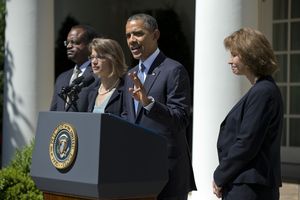![Justice Breyer Talks Challenges For Court [video : 80951298]](http://videos.usatoday.net/Brightcove2/29906170001/2016/02/29906170001_4774463809001_thumb-f3c70fae28657e0a910f6a706700240b.jpg?pubId=29906170001)
WASHINGTON — The person President Obama nominates to replace Antonin Scalia on the Supreme Court not only will have big shoes to fill — he or she may have many shoes to fill.
![Supreme Court nominees [image : 80879514]](http://www.gannett-cdn.com/-mm-/db163a9880b03cffea24382aefa27d8ef127e75a/c=834-0-4797-3387/local/-/media/2016/02/24/USATODAY/USATODAY/635919366232259190-A05-OBAMA-JUDGES-05.jpg)
Despite Senate Republicans' vow to ignore whoever Obama picks and wait for the next president's inauguration, Obama again made clear last week his intention to put forth a nominee with "a sterling record, a deep respect for the judiciary’s role (and) an understanding of the way the world really works."
![Obama expects Senate to back down on threats to block hearing for nominee [oembed : 80919446] [oembed : 80919446] [oembed : 80919446] [oembed : 80919446] [oembed : 80919446] [oembed : 80919446] [oembed : 80919446] [oembed : 80919446] [oembed : 80919446] [oembed : 80919446] [oembed : 80919446] [oembed : 80919446] [oembed : 80919446] [oembed : 80919446] [oembed : 80919446] [oembed : 80919446] [oembed : 80919446] [oembed : 80919446] [oembed : 80919446] [oembed : 80919446] [oembed : 80919446] [oembed : 80919446]](/Portals/_default/Skins/PrestoLegacy/CommonCss/images/smartembed.png)
![GOP Senate leaders to meet with Obama to discuss Supreme Court vacancy [oembed : 80983322] [oembed : 80983322] [oembed : 80983322] [oembed : 80983322] [oembed : 80983322] [oembed : 80983322] [oembed : 80983322] [oembed : 80983322] [oembed : 80983322] [oembed : 80983322] [oembed : 80983322] [oembed : 80983322] [oembed : 80983322] [oembed : 80983322]](/Portals/_default/Skins/PrestoLegacy/CommonCss/images/smartembed.png)
But those are not the only considerations likely being weighed by the White House. Given the unusual circumstances involved in this constitutional showdown over a nominee who may be dead on arrival, the president might try to choose someone who checks several boxes.
Here's a look at the factors that will go into Obama's selection, according to legal and political allies:
1. Top-notch qualifications. This usually means a federal appeals court judge with a strong record in the legal mainstream, such as Obama's first nominee, Sonia Sotomayor. His second, former U.S. solicitor general and Harvard Law School dean Elena Kagan, is the only sitting justice who did not come from the federal bench.
2. Previous Senate confirmation. The best way to win support in the Senate is to show you've had that support in the past — perhaps even unanimously. Some of those likely on Obama's short list, including federal appeals court judges Sri Srinivasan of the D.C. Circuit (97-0 in 2013) and Jane Kelly of the 8th Circuit (96-0 the same year), fit that bill.
![GTY 166233496 A POL GOV USA DC [image : 80919642]](http://www.gannett-cdn.com/media/2016/02/25/USATODAY/USATODAY/635919881964485588-GTY-166233496.jpg)
3. Age. Presidents want to get maximum mileage out of their life-tenured justices, which usually means choosing someone between 40 and 60. Oft-mentioned California Supreme Court Justice Leondra Kruger, at 39, is probably too young. Diane Wood, 65, chief judge of the 7th Circuit Court of Appeals and a finalist for the last high court opening, is likely too old.
4. Race. The nation's first African-American president might want to choose a black nominee to join conservative Justice Clarence Thomas on the bench. There are several examples on the short list, led by Paul Watford, a judge on the 9th Circuit Court of Appeals, and Attorney General Loretta Lynch, who won relatively narrow Senate confirmation 10 months ago. Ketanji Brown Jackson, a federal district court judge for the District of Columbia, could also be a possibility.
![AP OBAMA A FILE USA DC [image : 80919606]](http://www.gannett-cdn.com/media/2016/02/25/USATODAY/USATODAY/635919881344381613-AP-Obama.jpg)
5. Ethnicity. Obama named the first Hispanic justice in 2009 by choosing Sotomayor and has sprinkled the federal bench with judges of other heritages who may be poised to take a step up. Besides Srinivasan, who was born in India, they include Vietnamese-born Jacqueline Nguyen of the 9th Circuit Court of Appeals, Mexican-born Mariano-Florentino Cuéllar of the California Supreme Court and Cuban-born Adalberto Jordan of the 11th Circuit Court of Appeals.
6. Gender. With three female justices on the court, led by 82-year-old Ruth Bader Ginsburg, gender may be less crucial than in 2009 and 2010. Still, a fourth woman — perhaps California Attorney General Kamala Harris or D.C. Circuit Court of Appeals Judge Patricia Millett — would serve Obama's goal of gender equality. (Harris, who is African American and Asian American, fills more criteria than anyone, but she's the favorite to win a Senate seat in November.)
![AP OBAMA A FILE USA CA [image : 80919680]](http://www.gannett-cdn.com/media/2016/02/25/USATODAY/USATODAY/635919883235893738-AP-Obama.1.jpg)
7. Geography. Until Scalia's death, four of the nine justices hailed from New York City. Only one is from the Midwest — Chief Justice John Roberts grew up in Indiana — and Justice Anthony Kennedy of California is the only one from west of the Mississippi River, though Justice Stephen Breyer, was raised in San Francisco before settling in Boston. If Obama wants more geographic diversity, Srinivasan (Kansas), Kelly (Iowa) or Sen. Amy Klobuchar (Minnesota) would fit the bill.
8. Education. Scalia bemoaned judicial overreach on same-sex marriage last year by a court "which consists of only nine men and women, all of them successful lawyers who studied at Harvard or Yale Law School." If the president wants to supplement those ivory towers, he could choose Srinivasan (Stanford), Watford (UCLA) or perhaps U.S. Solicitor General Donald Verrilli, who strayed as far as Columbia Law School. (Ginsburg, after two years at Harvard, actually got her law degree from Columbia as well.)
![AP SUPREME COURT PAY FOR DELAYING GENERICS A FILE USA DC [image : 80919758]](http://www.gannett-cdn.com/media/2016/02/25/USATODAY/USATODAY/635919884119951405-AP-Supreme-Court-Pay-for-Delaying-Generics.jpg)
9. Religion. The court's East Coast and Harvard/Yale bias is matched by a third anomaly — it's inhabited by only Catholics and Jews. With the 2010 retirement of Justice John Paul Stevens, the court has no Protestants (or any other religion, for that matter). Several candidates would provide religious diversity, from Srinivasan (Hindu) to Millett (Methodist) to Harris (Baptist).
10. Job experience. The current court includes former prosecutors such as Sotomayor and Justice Samuel Alito but no defense attorneys such as the late Thurgood Marshall — an occupation that can mean representing resumé-challenging criminals. Kelly or Judge Robert Wilkins of the D.C. Circuit Court of Appeals, who were both public defenders, would change that.
11. Political experience. Another thing missing from the court is a politician or public official in the mold of Chief Justice Earl Warren, the ex-governor of California, or Justice Hugo Black, a U.S. senator from Alabama. Obama could choose former Massachusetts governor Deval Patrick or any of a number of senators, including Christopher Coons of Delaware or Sheldon Whitehouse of Rhode Island.
![AP OBAMA A USA MA [image : 80919808]](http://www.gannett-cdn.com/media/2016/02/25/USATODAY/USATODAY/635919885377943469-AP-Obama.3.jpg)
12. Moderate or Republican. Obama could try to lure Senate Republicans with a more conservative nominee than they likely would get if a Democrat wins the White House in November. That might mean Chief Judge Merrick Garland of the D.C. Circuit Court of Appeals, who at 63 is also older than the typical nominee. Nevada Gov. Brian Sandoval, a former federal district court judge and a Republican, was mentioned as a possible nominee last week but told the White House he did not want to be considered.
13. Unapologetic liberal. Finally, there is the option of taking Republicans at their word and choosing an ill-fated nominee who will motivate the Democratic base in November. That could be a civil rights lawyer such as Pamela Karlan of Stanford Law School, a gay rights and voting rights champion such as Supreme Court advocate Paul Smith, or a women's rights heroine in the Ginsburg mold such as Judge Nina Pillard of the D.C. Circuit Court of Appeals.


